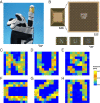Near-hysteresis-free soft tactile electronic skins for wearables and reliable machine learning
- PMID: 32989151
- PMCID: PMC7568242
- DOI: 10.1073/pnas.2010989117
Near-hysteresis-free soft tactile electronic skins for wearables and reliable machine learning
Abstract
Electronic skins are essential for real-time health monitoring and tactile perception in robots. Although the use of soft elastomers and microstructures have improved the sensitivity and pressure-sensing range of tactile sensors, the intrinsic viscoelasticity of soft polymeric materials remains a long-standing challenge resulting in cyclic hysteresis. This causes sensor data variations between contact events that negatively impact the accuracy and reliability. Here, we introduce the Tactile Resistive Annularly Cracked E-Skin (TRACE) sensor to address the inherent trade-off between sensitivity and hysteresis in tactile sensors when using soft materials. We discovered that piezoresistive sensors made using an array of three-dimensional (3D) metallic annular cracks on polymeric microstructures possess high sensitivities (> 107 Ω ⋅ kPa-1), low hysteresis (2.99 ± 1.37%) over a wide pressure range (0-20 kPa), and fast response (400 Hz). We demonstrate that TRACE sensors can accurately detect and measure the pulse wave velocity (PWV) when skin mounted. Moreover, we show that these tactile sensors when arrayed enabled fast reliable one-touch surface texture classification with neuromorphic encoding and deep learning algorithms.
Keywords: electronic skin; machine learning; robotics; sensor; wearable.
Conflict of interest statement
The authors declare no competing interest.
Figures






Similar articles
-
Epidermis-Inspired Wearable Piezoresistive Pressure Sensors Using Reduced Graphene Oxide Self-Wrapped Copper Nanowire Networks.Small Methods. 2022 Jan;6(1):e2100900. doi: 10.1002/smtd.202100900. Epub 2021 Dec 15. Small Methods. 2022. PMID: 35041280 Free PMC article.
-
Rapid-Response, Low Detection Limit, and High-Sensitivity Capacitive Flexible Tactile Sensor Based on Three-Dimensional Porous Dielectric Layer for Wearable Electronic Skin.ACS Appl Mater Interfaces. 2019 Oct 30;11(43):40716-40725. doi: 10.1021/acsami.9b16511. Epub 2019 Oct 21. ACS Appl Mater Interfaces. 2019. PMID: 31596567
-
Wearable System Integrating Dual Piezoresistive and Photoplethysmography Sensors for Simultaneous Pulse Wave Monitoring.ACS Appl Mater Interfaces. 2024 Nov 27;16(47):65402-65413. doi: 10.1021/acsami.4c17710. Epub 2024 Nov 12. ACS Appl Mater Interfaces. 2024. PMID: 39531594
-
Three-Dimensionally Architected Tactile Electronic Skins.ACS Nano. 2025 Apr 22;19(15):14523-14539. doi: 10.1021/acsnano.5c02232. Epub 2025 Apr 7. ACS Nano. 2025. PMID: 40194921 Review.
-
Electronic skins and machine learning for intelligent soft robots.Sci Robot. 2020 Apr 22;5(41):eaaz9239. doi: 10.1126/scirobotics.aaz9239. Epub 2020 Apr 22. Sci Robot. 2020. PMID: 33022628 Review.
Cited by
-
Bioinspired robot skin with mechanically gated electron channels for sliding tactile perception.Sci Adv. 2022 Dec 2;8(48):eade0720. doi: 10.1126/sciadv.ade0720. Epub 2022 Dec 2. Sci Adv. 2022. PMID: 36459548 Free PMC article.
-
A Miniature Soft Sensor with Origami-Inspired Self-Folding Parallel Mechanism.Micromachines (Basel). 2022 Jul 28;13(8):1188. doi: 10.3390/mi13081188. Micromachines (Basel). 2022. PMID: 36014110 Free PMC article.
-
Recent advances in hydrogel-based flexible strain sensors for harsh environment applications.Chem Sci. 2024 Oct 8;15(43):17799-822. doi: 10.1039/d4sc05295a. Online ahead of print. Chem Sci. 2024. PMID: 39430943 Free PMC article. Review.
-
Multimodal Finger Pulse Wave Sensing: Comparison of Forcecardiography and Photoplethysmography Sensors.Sensors (Basel). 2022 Oct 6;22(19):7566. doi: 10.3390/s22197566. Sensors (Basel). 2022. PMID: 36236663 Free PMC article.
-
Ultrafast piezocapacitive soft pressure sensors with over 10 kHz bandwidth via bonded microstructured interfaces.Nat Commun. 2024 Apr 8;15(1):3048. doi: 10.1038/s41467-024-47408-z. Nat Commun. 2024. PMID: 38589497 Free PMC article.
References
-
- Gardner Esther P, “Touch” in Encyclopedia of Life Sciences (ELS), (John Wiley & Sons, Ltd, Chichester, 2010), 10.1002/9780470015902.a0000219.pub2. - DOI
-
- Kim D.-H. et al. ., Epidermal electronics. Science 333, 838–843 (2011). - PubMed
-
- Niu S. et al. ., A wireless body area sensor network based on stretchable passive tags. Nat. Electron. 2, 361–368 (2019).
-
- Boutry C. M. et al. ., A stretchable and biodegradable strain and pressure sensor for orthopaedic application. Nat. Electron. 1, 314–321 (2018).
Publication types
MeSH terms
LinkOut - more resources
Full Text Sources

